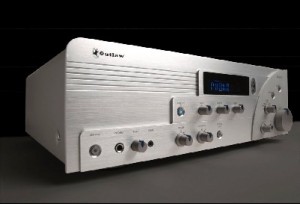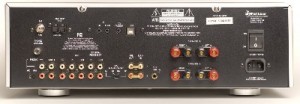Audio Section
Continuous Average Power:
100 watts per channel, 20 Hz – 20kHz,<0.03% THD, both channels driven into 8 ohms
160 watts per channel, 20 Hz – 20kHz,<0.03% THD, both channels driven into 4 ohms
Input Sensitivity/Impedance:
High Level: 200mV/47kohms
MM Phono: 3.3mV/47kohms
MC Phono: 0.6mV/47kohms
S/N Ratio: 96dB
Bass Management:
Adjustable 60/80/100/Bypass
High-Pass Slope 12 dB/octave (2nd order)
Low-Pass Slope 12 dB/octave (2nd order)
Tone Control:
Bass Center Frequency/Range: 50Hz ± 6.5dB
Treble Center Frequency/Range: 1KHz ± 6.5db

FM Tuner Section
Frequency Range: 87.5-108MHz
Usable Sensitivity IHF: 12dBf
Signal-to-Noise Ratio: Mono/Stereo 75/70dB
Stereo Distortion: 0.24%
Stereo Separation: 37dB @ 19kHz
Selectivity: +/-10kHz, 70dB
AM Tuner Section
Frequency Range: 530-1710kHz
Usable Sensitivity: 500uV/M
Signal-to-Noise Ratio: >54dB
Selectivity: +/-10kHz >25dB General
Supply Voltage 120V, 60Hz only
Power Consumption:
5W Idle
400W maximum, both channels driven
Dimensions:
(HxWxD) 5.75 x 17.1 x 15 in. Weight 27 lbs
Outlaw RR 2150 review:
Outlaw Audio’s “retro” receiver was nearly an idea whose time never came. Production was repeatedly delayed, to the
point that it became an item of nearly mythological proportions. But, like so many other things in life, the 2150 has emerged as undisputed proof that good things are worth waiting for.
Although it can be a fatal flaw for audiophile opinions to be skewed by a product’s looks, an exception has to be made for the 2150. With its sweeping metal face, large, blue digital readout and one-of-a-kind design, it is indeed striking. And it’s heavy – at 27 pounds, it presents a solid, no plastics fit and feel.
Straight operation with FM, CD and the moving magnet phono output as sources were tested here (the unit also has a moving-coil cartridge option). Although “retro” in appearance with a nod to the lovely Bakelite radios of the late 1930s and 1940s, the 2150 boast such 21st-century accoutrements as an MP3-player input and USB hookup, should the listener want to link it to a home computer.
Instead of a conventional “loudness” control, the 2150 features a bass boost at selected frequencies. This will particularly appeal to listeners who have bookshelf-style speakers that can use a little extra “oomph.” Adding a sub? The receiverboasts a two channel version of the “bass management” function found in home theater receivers (you’ll need a sub whose built-in crossover can be bypassed to enjoy this feature.)
As always, it’s the music that counts, and those coming from a mid-fi receiver will immediately notice a delicious transparency, particularly on string selections. In honor of the season, we pulled out Leroy Anderson’s venerable “Sleigh Ride” (Naxos). Our slender Polk towers threw an unusually wide soundstage with this recording, and it was nearly possible to denote each individual string instrument. The trumpets boasted plenty of bite, and the “whip” was holography suspended above and to the right of the left speaker.
With renewed interest in recordings from the 1950s, we put the 2150 up against the formidable RCA “Living Stereo” re-release of Gershwin’s “Rhapsody in Blue” by Arthur Fiedler and the Boston Pops. Even without benefit of SACD reproduction, this classic exhibited a realistic front-to-back orchestral presentation and a heart-stopping dynamic range. The receiver packs an honest 100 watts of power, and never developed heat or seemed to strain.
On the jazz side, pianist Jacques Loussier’s rendition of Ravel’s “Bolero” (Telarc) remains one of the finest jazz-trio recordings ever, particularly noteworthy for the reproduction of Benoit Dunoyer de Segonzac’s exquisite standup-bass lines. This is the kind of track that would sound good on the weakest of systems, but in the hands of the 2150, it is nothing short of hypnotic.
Stereo devotees are frequently vinyl fans as well, and the receiver’s phono stage tested quite well. Female vocals are always a good measure, and the Classic Records 200-gram pressing of Norah Jones’ “Come Away With Me” made the popular singer’s voice
sound almost eerily lifelike, completely natural and uncolored. (The realism of the slide guitar on “Lonestar” and the solid punch of the bass on “I’ve Got To See You Again” are also worth noting.)
More good points? The manual is unusually complete, and Outlaw customer service is deservedly legendary. Weaknesses? They are few and far between. With the remote, the volume control is imprecise, and radio-station presetting has a bit of a learning curve. But these are minor piffles. Outlaw has a major hit on its hands, and deservedly so. Without any sort of conventional marketing, the 2150 has already been out of stock twice since its introduction in November. It seems that interest in stereo is alive and well, particularly among those willing to look beyond the Denon’s and Sony’s of the world and latch onto a product as unique and noteworthy as this.
Outlaw Audio RR 2150 Receiver Price: $699
Manufacturer website: http://www.outlawaudio.com/products/rr2150.html
Associated equipment:
- Polk Audio Monitor 70 speakers,
- Canare 4S11 cable,
- Panasonic RV-32
- CD/DVD player, NAD 533 turntable, Rega Super
- Elys cartridge.


